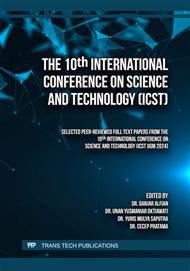[1]
A.A. Fisu, "Identifikasi Awal Lokasi Rencana Pelabuhan di Teluk Prigi Kabupaten Trenggalek," UPNVJ J., vol. 2, p.1–15, 2017, [Online]. Available: https://osf.io/preprints/inarxiv/c82h6/
DOI: 10.31227/osf.io/c82h6
Google Scholar
[2]
S. Asatidz, A. Satriadi, A. Ismanto, H. Setiyono, and P. Purwanto, "Pemodelan Sebaran Sedimen Dasar di Perairan Pelabuhan Branta, Pamekasan," Indones. J. Oceanogr., vol. 3, no. 1, p.64–75, 2021.
DOI: 10.14710/ijoce.v3i1.10184
Google Scholar
[3]
P.M.K. dan P.R.I. 2012, "Peraturan Menteri Kelautan dan Perikanan RI Nomor PER.08/MEN/2012 Tentang Kepelabuhanan Perikanan," p.1–20, 2012.
DOI: 10.30996/jpap.v2i02.1003
Google Scholar
[4]
"Pemetaan Batimetri dalam Pekerjaan Mendesain Alur Pelayaran, Area Labuh, dan Kolam Putar di Area Pelabuhan (Studi Kasus: Pelabuhan Branta, Jawa Timur)," p.1–14, 2023, [Online]. Available: https://www.ncbi.nlm.nih.gov/books/NBK558907/
DOI: 10.13170/depik.3.1.1356
Google Scholar
[5]
M.H. Abdillah, R. Djaja, and A.L. Ibrahim, "Pembuatan Peta Laut berdasarkan S-4 dan S-57 Internasional Hydrographic Organization (IHO) menggunakan Perangkat Lunak ArcGIS 10.4.1," J. Online Mhs. Bid. Tek. Geod., vol. 1, no. 1, p.1–10, 2018.
Google Scholar
[6]
Poerbandono and G. Alodia, Survei Pencarian Bawah Laut. August 2018.
Google Scholar
[7]
A. Hidayat., B. Sasmito, and B. Sudarsono., "Survei Bathimetri Untuk Pengecekan Kedalaman Perairan Wilayah Pelabuhan Kendal," J. Geod. Undip, vol. 5, no. 2, p.1–8, 2016.
Google Scholar
[8]
S.K. Kartal, R. Hacıoğlu, K.S. Görmüş, H. Kutoğlu, and M.K. Leblebicioğlu, "Modeling and Analysis of Sea-Surface Vehicle System for Underwater Mapping Using Single-Beam Echosounder," J. Mar. Sci. Eng., vol. 10, no. 10, 2022.
DOI: 10.3390/jmse10101349
Google Scholar
[9]
W.W. Wijonarko, B. Sasmito, and A.L. Nugraha, "Kajian Pemodelan Dasar Laut menggunakan Side Scan Sonar dan Singlebeam Echosounder," vol. 5, no. April, p.168–178, 2016.
Google Scholar
[10]
Poerbondono and Ek. Djurnasjah, "Survei Hidrografi", 2005.
Google Scholar
[11]
T. Efendi, D. S. Mulyadi, A. Prasetyo, A. Amril, A. Kusuma, and A. I. Santoso, "Komparasi Pengolahan Data Side Scan Sonar Menggunakan 2 (dua) Perangkat Lunak Triton Imaging Isis dan Sonarwiz (Studi Kasus Perairan Batam Kepulauan Riau)," J. Hidropilar, vol. 5, no. 1, p.27–34, 2019.
DOI: 10.37875/hidropilar.v5i1.157
Google Scholar
[12]
H.M. Manik, L. Junaedi, and G. Harsono, "Pemrosesan Citra Side Scan Sonar untuk Pemetaan Dasar Laut Pelabuhan Benoa," J. Nas. Tek. Elektro dan Teknol. Inf., vol. 5, no. 2, 2016.
DOI: 10.22146/jnteti.v5i2.231
Google Scholar
[13]
R. Nurkhayati and H. M. Manik, "GIS Untuk Integrasi Interpretasi Substrat Dasar Perairan menggunakan Penggolahan Citra ALOS-AVNIR dan Side Scan Sonar," J. Otomasi Kontrol dan Instrumentasi, vol. 8, no. 1, p.25, 2016.
DOI: 10.5614/joki.2016.8.1.3
Google Scholar
[14]
E. Supriyadi, S. Siswanto, and W. S. Pranowo, "Karakteristik Pasang Surut di Perairan Pameungpeuk, Belitung, dan Sarmi Berdasarkan Metode Admiralty," J. Meteorol. dan Geofis., vol. 19, no. 1, p.29, 2019.
DOI: 10.31172/jmg.v19i1.518
Google Scholar
[15]
M. Ulum and Khomsin, "Perbandingan Akurasi Prediksi Pasang Surut antara Metode Admiralty dan Metode Least Square," vol. 09, 2013.
DOI: 10.12962/j24423998.v9i1.746
Google Scholar
[16]
A. U. Ekpa and N. I. Eyakndue, "Determination of a Section of Woji Riverbed Depths for Safe Navigation," Niger. J. Environ. Sci. Technol., vol. 1, no. 1, p.55–68, 2017.
DOI: 10.36263/nijest.2017.01.0033
Google Scholar
[17]
A. Makar, "Simplified Method of Determination of the Sound Speed in Water on the Basis of Temperature Measurements and Salinity Prediction for Shallow Water Bathymetry," Remote Sens., vol. 14, no. 3, 2022.
DOI: 10.3390/rs14030636
Google Scholar
[18]
IHO, "International Hydrographic Organization Standards for Hydrographic Surveys International © Copyright International Hydrographic Organization 2020," no. 377, 2022.
DOI: 10.1093/law:epil/9780199231690/e489
Google Scholar
[19]
2017 Direktorat Jenderal Perhubungan Laut, "Petunjuk Teknis Batas-Batas Daerah Lingkungan Kerja (DLKr) dan Daerah Lingkungan Kepentingan Pelabuhan,", 2017.
DOI: 10.46484/db.v1i1.187
Google Scholar
[20]
"Undang Undang No 17 Tahun 2008 Tentang Pelayaran," , 2008.
Google Scholar


